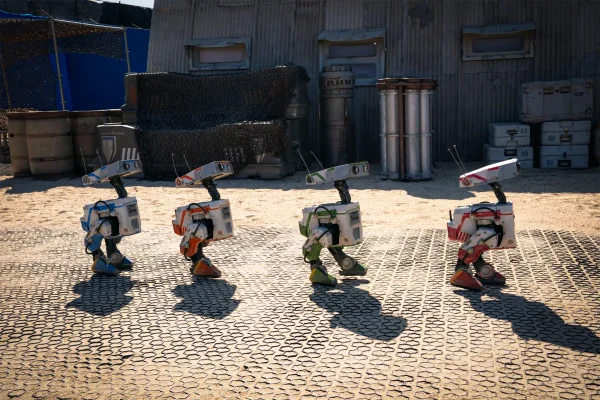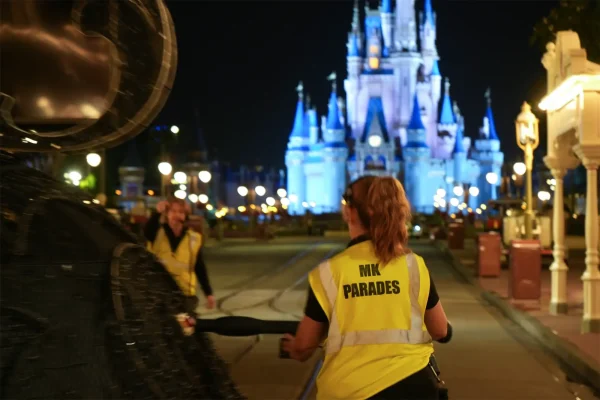Exploring the Magic: D23’s Walt Disney Studios Tour

The Walt Disney Studio Lot in Burbank, California, is a treasure trove of drawings and archives spanning 100 years. Thanks to D23’s Walt Disney Studios Tour, I had the incredible privilege of visiting this enchanting place and stepping inside Walt Disney’s personal office. Visiting these historic buildings is like stepping back in time. Walking on the same grounds where Walt Disney once held his business meetings and crafted entertainment for the world is not just an experience; it’s a journey through history. It’s a chance to connect with the man behind the magic and understand the roots of the Disney phenomenon.

Check-In
Our Walt Disney Studios Tour adventure began with a check-in, where we received our exclusive D23 ID badges, symbolizing our access to this magical world. We were then introduced to our fantastic tour guide, a Disney enthusiast who shared our passion for Disney’s magic. The tour, was two and a half hours packed with fascinating history and enchanting sights, a journey that took us through the heart of Disney’s legacy.
Our Walt Disney Studios Tour began with an introduction to the Mickey topiary, the flag poles from the 1960 Olympics (where Walt was the Chairman of Pageantry), and the original buildings that were moved to the studio lot. The Mickey topiary was a gift from Walt Disney World for Mickey’s birthday, but it kept dying until they used California native plants. The flag poles were a gift to the company and fly the corporate and US flags. The relocated buildings included the company store and the Hyperion building.



Dopey Drive
We then stopped at Dopey Drive, where this sign is an iconic part of the Studios. It was used as a shot for the film The Reluctant Dragon, but they decided not to take it down, and it still stands there today. On the floor next to it was Pluto’s corner. There are three paw prints in the cement as a fun little detail to Mickey’s fun-loving, naughty dog.




Animation Building
Stroll through the Animation Building, where beloved classics such as Cinderella, Lady and the Tramp, and The Jungle Book were brought to life. The building walls pay homage to the entire animation process, from its inception to the final product. Numerous design concepts, animation cels, and visual development pieces are displayed. This part of the tour was lovely and inspiring. Can you guess which movie the concept art is from?

















Did you know that there are hidden tunnels beneath the original Disney animation studio buildings? These tunnels add an intriguing and mysterious element to the world of Disney animation. Although the tunnels may seem unusual, they served a practical purpose. During the era of hand-drawn animation, they allowed animators to move animation cels from one building to another without exposing them to the elements, thus protecting the precious artwork. This ensured that animators could progress through the animation process without risking damage to their work. While the tunnels may appear eerie, as underground passageways often do, they were a sensible solution to protect the delicate animation process in Burbank’s environment.

Walt Disney’s Office
After touring the lower floors of the animation building, we headed to the third floor to check off one of my last Disney bucket list items – a visit to Walt’s office. Walt occupied this office from 1940 until his passing in 1966. Throughout his lifetime, office 3H was the creative hub of what we now know as the Walt Disney Company. In 2015, the Walt Disney Archives and the Disney Studio artisans restored this historic space to its late 1960 grandeur, aiming to bring inspiration and joy to all who visit this revered place. You can explore the secretary’s office, formal office, and private room within this space. The secretary’s office and reception were gateways to Walt, and he was rarely seen without an appointment. Many of Walt’s awards are displayed in the office. He received 960 awards and citations in his lifetime, some showcased in the office, including his 10th service anniversary at Disneyland.






I also learned that some of the artifacts in the secretary’s office are props from Mary Poppins. Moving on to a very emotional space for me, Walt’s Formal office is where important guests were received, and Walt spent most mornings reading fan mail and signing letters. The grand piano in this office has hosted the likes of Leopoldo Stokowski and the Sherman Brothers. On this piano, Walt often requested the Sherman Brothers to play his favorite, “Feed the Birds,” on many Friday afternoons. This piano holds significant historical value, and I was deeply moved upon seeing it. When the suite reopened in 2015, Richard Sherman played “Feed the Birds” in that very office in Walt’s honor.
Other prized possessions in this office include a credenza filled with knickknacks and gifts from around the globe, Norman Rockwell sketches of his daughters, and books written by P.L. Travers, C.S. Lewis, Upton Sinclair, and other well-known authors. A surprising find for me was a gold-caged automaton bird that sparked Walt’s imagination, creating what we now know as audio-animatronics. This invention later inspired The Enchanted Tiki Room. In this space, Walt found solace and a place for creativity away from the outside world.











Moving on to the working space, the working office was one of my favorite aspects. The walls feature various projects that Walt worked on before his death, preserved precisely as Walt had left them. It’s said that this little office often had wall-to-wall people. Behind his desk were scripts, treatments, and outlines for the current project in the works around the studio. From film productions to work on EPCOT, many of the company’s beloved projects took shape in this very room. A small detail I loved about the Haunted Mansion was a note that read “Future home of 1001 ghosts”, showing that everything is constantly evolving and moving forward. In this room, Walt also had his tiny kitchen, where he kept his favorite whiskey, Scotch Mist, available at Carthay Circle in Disney’s California Adventure Park.



Walt had his own kitchen, where he made his beloved “Walt’s Chili,” which you can still get at Carnation Cafe in Disneyland. The glasses on display were the ones he used, adorned with his initials, WED. Moving into the Private Room, which functioned as a bedroom and bathroom, Walt often relaxed and received physical therapy each evening before heading home. The archives have reimagined this space as a gallery space. Upon exiting, each guest gets exclusive pins.






Michael D. Eisner Building and Legend’s Plaza
The Michael D. Eisner Building, a grand architectural marvel completed in 1990, is a tribute to the enduring legacy of Walt Disney’s groundbreaking animated films. Adorned with seven Dwarfs supporting its structure, the building symbolizes Disney’s creative excellence. It houses the esteemed office of Robert Iger and the directors’ boardroom, replacing the former Animation building.

Nestled beneath this impressive edifice is Legends Plaza, a captivating and respectful tribute to the remarkable individuals who have significantly contributed to Disney’s rich heritage. At the heart of this plaza stands the celebrated “Partners” statue of Walt Disney and Mickey Mouse. Bronze plaques displaying the handprints, signatures, and messages of Disney Legends surround the statue. Yearly, new honorees are commemorated, ensuring that their impact and legacy endure for future generations.

Legends Plaza offers enthralling insights into the creative trailblazers behind some of Disney’s most beloved stories and characters. It invites visitors to appreciate the immense talent and innovation that has shaped Disney’s extraordinary history. You’d recognize the significance of these remarkable individuals.










Walt Disney Archives
We then moved into the Walt Disney Archives, which Dave Smith founded in 1970. The Archives contain various historical items, including documents, photographs, props, costumes, artwork, and memorabilia that showcase Disney’s rich heritage and evolution. The Walt Disney Archives play a significant role in preserving the company’s history, providing resources for research and exhibitions, and supporting Disney’s storytelling across different media. It documents and celebrates the cultural impact of Disney’s creations, from iconic animated films and theme parks to television shows and merchandise.
While access to the archives is usually restricted, portions of the collection are sometimes put on display for scholarly research or tours. During our visit, we saw a cabinet full of Donald Duck merchandise, the telegram Walt sent to Roy after losing the rights to Oswald the Lucky Rabbit, and one of the oldest items in the archives, Alice Comedies movie posters. The archives contain so much valuable information that one could easily spend hours exploring. I always cherish the opportunity to visit. One extraordinary moment was being able to hold one of Walt’s Oscars. Did you know that Walt is the person who single-handedly won the most Oscars? He won 22 in his lifetime, and the Oscar we had the chance to hold was for the 1958 nature documentary film “White Wilderness.” We also had the opportunity to see the multiplane cameras. Three remain: at the studio, at the Walt Disney Family Museum in San Francisco, and at Disneyland Paris.







Ink & Paint
The Ink & Paint Building at the Walt Disney Studios was notable because women predominantly handled the task of inking and painting animation cels, especially during the mid-20th century when animation was predominantly done by hand. Women were often hired for these positions because the work was deemed to require a steady hand and attention to detail, which were stereotypically associated with women at that time. Moreover, these roles, though considered less technical and more repetitive compared to positions like animating or directing, which were generally occupied by men, played a crucial role in the overall production process. Their work significantly influenced the vibrant and iconic look of Disney animated films, marking a significant chapter in animation history.






Sound Stages
During our tour, we visited several stages at the studio. One of the stages, stage 3, is known as The Julie Andrews Stage, where Mary Poppins and The Princess Diaries were filmed. We also learned about the famous water tower, designed with six legs to make it appear more dominant than other studio towers. Additionally, the tour included a visit to the soundstages where iconic films such as 20,000 Leagues Under the Sea, Pirates of the Caribbean: The Curse of the Black Pearl, The Mandalorian, and Guardians of the Galaxy Vol. 2 were filmed.


Exclusive Shopping Opportunities
The tour concludes with a visit to the Disney Studio Store and Employee Center, where exclusive items are available. This is a dream come true for Disney fans who love exclusive merchandise.




Conclusion
I can’t recommend the Walt Disney Studios Tour enough. Walking through the same grounds where Walt Disney himself once roamed is an unforgettable experience. You feel the magic of Walt, the Company, and the Cast Members. These D23 tours sell out quickly. Book them immediately when they become available. You won’t regret it.
Visit the D23 website for more information on the Walt Disney Studios Tour.




